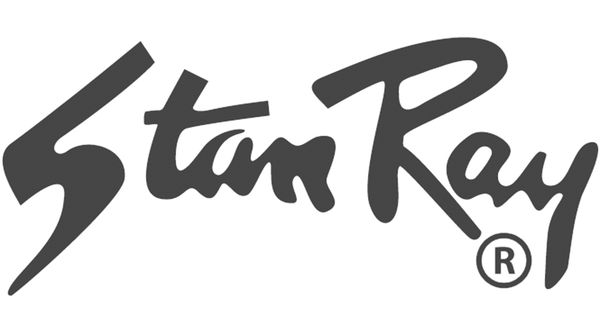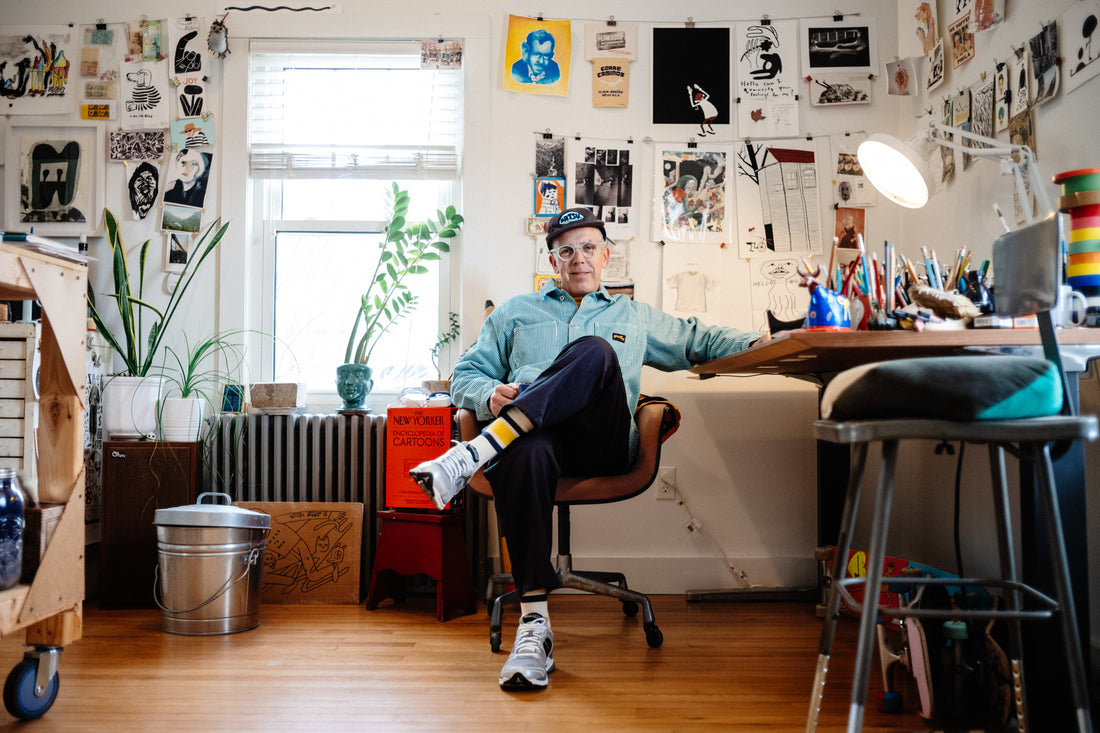Stan Ray Meets Russ Pope
Drawing isn’t easy. Anyone can grab a pen and jot down a quick doodle—but actually capturing someone’s character with just a few lines on a sheet of paper is a rare skill that takes years to hone.
Russ Pope is one of the few who has truly mastered it. Whether it’s a sketch on a skateboard or a painting in a gallery, his loose, freehand work translates everyday moments into the transcendent.
We caught up with him at his studio in New Hampshire to find out more about his process…

I suppose I wanted to talk mostly about your drawings. Everyone draws and paints when they’re young—but what kept you going?
I guess the fact that I love making drawings. Drawings are sort of like a daily diary in pictures instead of words for me. I do things like make a drawing of somebody that I heard say something ridiculous or make a drawing that’s representative of me feeling like I’m running around like an idiot one day… I’ll make a drawing of a bird sitting on my head and call it birdbrained. Or I’lll make drawings of my whole family hanging out together, instead of taking a photo of that scene, I’ll draw it.
So your drawing is like documentation? I suppose nowadays most people reach for their phone to document what’s going on around them, but you reach for the pen. Are there things that you can capture with a pen that maybe get lost with a photo?
I take a ton of photos too, but yes, I do think the drawings capture more personality, certain details like outfits or mood.
Definitely. How do you fit drawing into your life? Is it like, “Right, I sit down and draw 9-to-5 every day,” or is it a case of just getting something down when you feel like it?
I kind of draw off and on all day long. Sometimes it’s the way I start my day in the morning with coffee. Usually it’s as things pop into my head and I need to get them down—and the way I get them down is through drawings. There are times when it’s done very purposefully though as well. I’m kind of weird in that I’ll even have a sketchbook sometimes with me while I’m watching a movie, making drawings of characters that are interesting as I’m watching it.

I don’t know what I’m trying to say here, but your drawings have a real looseness or freedom to them. They don’t feel too pre-planned or forced. That strikes me as something that’s quite hard to achieve—how do you get to that point with your drawing?
Well first, thanks for that. I think that’s quite a compliment. I’d say it’s from practice, just like anything else, the more you do it, the more comfortable you are with it and the easier these things become. Maybe easier is a bad way to put it, but the more I draw, the more comfortable I feel drawing, and the more I enjoy it.
How do you know when something is finished? There’s always a temptation to add more to a drawing, but when is enough enough?
For me at least, that’s something that I’ve learned over time. Just many years of going through it. Whether it’s a drawing or a painting, knowing when to pause and walk away for a bit and come back to it, or just knowing when to stop. You’re right, 20 years ago I may have wanted to fill up all the space on the canvas or add more into the background foreground of a drawing. Now the goal is to tell a story or convey feeling or deliver a message with as few lines or strokes as possible.

Can you talk me through your studio set-up? What makes a good space to draw or paint in?
My space just needs to feel good. I like to have my music close by so I have a record player and records in my studio—this also helps keep me off a phone. I have lots of images, small drawings, paintings, postcards and things like that from friends as well as people whose work I admire pinned on the wall around my drawing table and record player for inspiration.
My ceiling is high. The lighting is good, I have three vintage shop lights that I bought and had installed. There’s just enough space to spread out. I have an up / down Herman Miller table that allows me to be comfortable and stand or sit when I want to, and a nice old 60s Eames padded shell chair on rollers that looks cool and is comfortable to sit in.

Nice. Do you have a uniform for when you’re working? What sort of clothes do you wear?
I do have a large stack of painting clothes and if I’m going to spend all day working with paint usually I'll wear stuff out of that. Painter pants, either long or cut off into shorts and an old t-shirt and crewneck sweatshirt usually. If I’m just at my drawing table, I’ll wear whatever I’m wearing that day. If I’m jumping back-and-forth, I have a shop apron from Stan Ray that I throw on before painting.
When you’re drawing do you think about the end result? Do you have the intention of making a t-shirt or something that’ll end up on a skateboard, or do you work the other way around—going back through what you’ve already done?
Usually when I’m drawing I’m just making drawings for the sake of drawing—and even if I know what I plan to draw beforehand, I’m making a drawing for the sake of drawing. I do set out to make drawings to be used in publications—a drawing of a place or space for a Juxtapoz article for instance, but when I’m making graphics to live on skateboards or t-shirts that sort of thing, more often than not, I make a drawing and then decide afterward, oh wow that would make a cool skateboard or cool T-shirt…

How does skateboarding feed into this? It seems like that can often spark people off into getting into art or music or photography—was that the case for you, or was the drawing already there?
Drawing was there but skateboarding certainly fostered, pushed, connected me with other creatives. It also gave me content and subject matter to make drawings of.
Why do you think skating does that with people quite often? I might be wrong, but I can’t imagine many people took up drawing or film-making because they were into javelin or something…
I can’t imagine that javelin or track and field produces lots of artists, designers and photographers either. I think skateboarders think they can do, or at least possibly do, whatever they’d like to do. We encourage our friends to go for it, and there are tons of practical applications for the arts in skateboarding. In skateboarding if you want to shoot photos, someone will lend you, or help you figure out how to get camera equipment. It’s the same if you want to make a painting or drawing.

Your work seems to gravitate towards people and faces and movement. Is there a through line that sort of carries through your drawings and paintings? What is it you’re trying to show?
Yeah, I’d say so, I think it’s reportage, or my life in pictures….. I do a fair amount of architectural stuff as well. People are almost always the subjects of my drawings and paintings though because I am super interested in folks and I am usually around them. So I guess yes—what I’m trying to show is life, or life as I see it through my very fortunate eyes.
That makes sense. Wrapping this up, have you got any wise words you’d like to add?
Well… life is short, try hard to make ‘it’ happen. Also, be nice to the folks around you.
Very special Thanks to Russ Pope
Photographs by Rob Collins
Interview by Sam Waller

